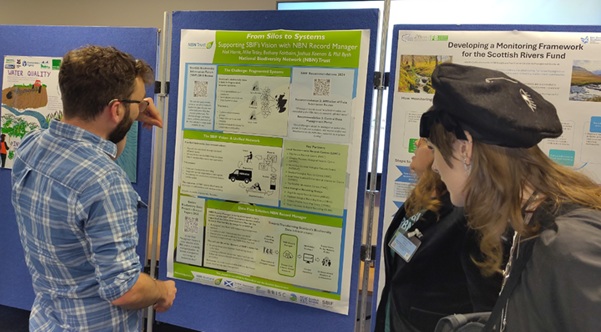A big thank you to CIEEM for a day that joined the dots from source-to-sea policy to hands-on restoration. As excellently described in the keynote by Dr Chris Leakey – Marine Sustainability Manager at NatureScot – there is a very compelling and urgent case for S2S coordination across our land, freshwater, coasts, and sea. This was echoed across the other informative sessions on catchment planning, 30×30 mapping, natural capital tools, and community-led habitat restoration.
The takeaway? Better data flows + shared tools = better outcomes for nature and society.
From the NBN Trust the Better Biodiversity Data (BBD) project’s new Data and Digital Services Manager – Neil Harris – showcased our poster “From Silos to Systems: Supporting SBIF’s Vision with NBN Record Manager”. This presentation introduced the CIEEM conference delegates to the Scottish Biodiversity Information Forum (SBIF) Recommendation’s need for a centrally managed system to improve biodiversity data standards and accessibility in Scotland. Neil highlighted the BBD project’s work to create a new online system that will streamline submissions via affiliated routes, apply shared data schema and vocabularies, and deliver seamless publishing to NBN Atlas Scotland – helping to make Scotland’s biodiversity data FAIR by making it more ‘Findable, Accessible, Interoperable, and Reusable’.

Built directly through engagement with Local Environmental Records Centres (LERCs) and recording groups, NBN Record Manager is designed to break down silos, enable verification, and link evidence to decisions – directly addressing SBIF Recommendations on affiliating submission routes (Rec 2) and creating central record-manager portals (Rec 6).
As the conference speakers highlighted, Scotland is moving fast – from restoration in the River Spey catchment and west coast seagrass beds, to new tools for 30×30 and the mapping of Scotland’s Natural Capital. Our role is clear: power that progress with a robust, shared data infrastructure.
The work of the NBN Trust’s BBD Project is supported by NatureScot and the Scottish Government, as well as RSPB, Scottish Wildlife Trust, BRISC, and Scotland’s vital Local Environmental Record Centres and local recording groups.
